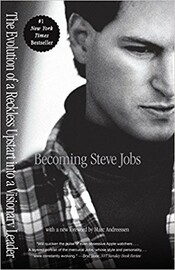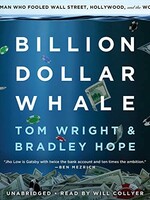
Becoming Steve Jobs - Book Summary
The Evolution of a Reckless Upstart into a Visionary Leader
Release Date: April 17, 2024
Book Authors: Brent Schlender and Rick Tetzeli
Categories: Biography & Memoir, Career & Success
Release Date: April 17, 2024
Book Authors: Brent Schlender and Rick Tetzeli
Categories: Biography & Memoir, Career & Success
In this episode of 20 Minute Books, we're exploring "Becoming Steve Jobs" a compelling narrative that dives deep into the life of one of technology's most iconic figures. Authored by veteran journalists Brent Schlender and Rick Tetzeli, this book provides an unparalleled inside look at the evolution of Steve Jobs, from an ambitious young man into a visionary leader whose work has left an indelible mark on the world of technology.
With Schlender's first-hand experience covering Jobs for over two decades at publications like the Wall Street Journal and Fortune, alongside Tetzeli's extensive background in technology journalism, including his roles at Fast Company and Entertainment Weekly, "Becoming Steve Jobs" draws from a wealth of intimate insights and professional encounters. This book not only traces the history of Apple but also delves into Jobs's personal development, exploring the intricate balance between his monumental successes and the challenges he faced.
Readers are taken on a journey that examines the birth of revolutionary products like the iPhone, showcasing how Jobs’s relentless drive and innovative spirit have forever changed the way we interact with technology. "Becoming Steve Jobs" is more than just a biography; it's a testament to the power of persistence, innovation, and visionary thinking.
This episode is crafted for Apple enthusiasts, admirers of Steve Jobs, computer lovers, and business leaders seeking to glean wisdom from one of history's most transformative entrepreneurs. Join us as we delve into the story of a man whose legacy continues to influence the technological landscape and inspire generations to come.
"Dismantling the Myth: The True Story of Tech's Maverick Innovator"
The legend of Steve Jobs looms large in the world of technology and beyond — a visionary, an icon, a trailblazer who redefined the contours of innovation. He was a man whose name became synonymous with ingenuity and the revolutionary products that have become the cornerstone of modern life, such as the iPhone. As the mastermind behind Apple, he steered the company to unprecedented heights, making it one of the most valuable and revered brands globally. Yet, beneath the sheen of success and acclaim, who was Steve Jobs?
The tapestry of stories woven about Jobs paints a complex picture. To some, he was the epitome of genius — a leader whose foresight and dedication to perfection were unparalleled. To others, he came across as overbearing — a difficult man driven by an uncompromising vision, often seen as a blend of brilliance and brashness. This narrative sets out to unravel the layers, charting the journey of how Steve Jobs transformed from a man into a legend.
In our exploration, we delve into the origins of Apple's name — a story rooted in simplicity and perhaps a hint of whimsy, characteristic of the man himself. We traverse the pivotal moments that shaped Jobs's career, including the unexpected role Pixar played in his eventual return to Apple. This return marked a renaissance, not just for Jobs but for Apple as well, steering the company back to its ethos of innovation and excellence.
Moreover, the narrative does not shy away from the battles — both personal and professional — that Jobs faced. One of the most poignant aspects of his story involves the creation of his final groundbreaking products in the face of a fierce struggle against death. In these moments, Jobs's indomitable spirit shines through, highlighting his unwavering pursuit of excellence even in the direst circumstances.
This is more than just the story of a tech luminary; it's a journey through the highs and lows, the triumphs and setbacks of a man whose life became a beacon of inspiration and controversy alike. Through uncovering the essence behind the man known as Steve Jobs, we gain insights into what it truly means to be a pioneer — to live a life dedicated to pushing the boundaries of what is possible, driven by an insatiable desire for innovation and perfection.
"The Genesis of a Genius: Steve Jobs's Early Tryst with Technology"
On a crisp February day in 1955, in San Francisco, the world unknowingly received a future tech maestro — Steve Jobs. His journey took a turning point shortly after birth when Joanna Schieble, his biological mother, made the decision for him to be adopted. Paul and Clara Jobs, a couple grounded in the values of the working class, brought him into their lives, setting the stage for Jobs's illustrious future.
The influence of his adoptive parents, particularly his father Paul — a car mechanic with a penchant for craftsmanship — played a pivotal role in Jobs’s early acquaintance with technology. The Jobs family garage became a sanctuary of sorts, where young Steve learned the art of crafting, deconstructing, and reconstructing under the watchful eye of his father. These lessons in meticulous attention to detail, such as ensuring the unseen parts of a cabinet were as well-finished as those in view, deeply influenced Jobs’s philosophy towards product design. This perspective was evident years later when he introduced innovations like the iPod, emphasizing the beauty within, not just the exterior.
Jobs’s intellect was undeniable. Demonstrating an exceptional grasp on subjects like math and science from a young age, he leaped over sixth grade and ventured into realms that would further fuel his passion for technology. His acceptance into the Explorers Club, a haven for young electronics aficionados at the Hewlett-Packard campus, marked his first hands-on encounter with a computer, setting the preliminaries of an extraordinary career in tech.
It wasn't long before Jobs, at the tender age of 21, co-founded Apple with Stephen Wozniak — a relationship born out of a mutual friend’s introduction. Wozniak, a prodigy in his own right, and Jobs, a visionary with an unrelenting drive, looked beyond the limitations of the then-current computing landscape. Together, they envisioned a machine that was not only personal but also accessible.
This vision materialized in the Jobs family garage, transitioning from mere idea to physical form as the Apple 1. With a small assembly line comprised of neighborhood kids, they embarked on assembling what would soon revolutionize the technology world. The name "Apple," reflective of an idyllic intersection between a nod to the Garden of Eden and Jobs’s reminiscences of an Oregon apple orchard, symbolized a new beginning — a dawn of innovation and user-centered computing that would forever alter the trajectory of our digital lives.
"From Garage to Silicon Valley Giant: The Rapid Rise of Apple"
With the creation of Apple and the launch of the Apple 1, Steve Jobs found his calling. This initial success—selling a groundbreaking dozen units every few weeks—was just the beginning. Although fewer than two hundred units of the Apple 1 were sold, it fueled the ambition and confidence of Jobs and his partner, Wozniak, to push the envelope even further.
Their aspirations took flight with the inception of the Apple II. Recognizing the need for substantial financial backing to realize their enhanced vision, Jobs managed to persuade A.C. "Mike" Markkula, a former executive at Intel, to believe in their dream. Markkula's investment was pivotal, offering an impressive $92,000 from his own funds and establishing a $250,000 line of credit for Apple. This influx of capital was a game-changer, marking the transition from a humble garage setup to a venture poised for greatness.
With the financial groundwork laid, Jobs and Wozniak were joined by Michael "Scotty" Scott, appointed as Apple’s first professional CEO. Moving operations to a legitimate office in Cupertino, the company was now in a position to pursue its ambitious project: creating a truly personal computer. The year 1977 witnessed the birth of the Apple II, a device that leapt miles ahead of its predecessor. It boasted a faster microprocessor, enhancing performance substantially, and came equipped with features such as an audio amplifier, speaker, and inputs for gaming, encapsulating the essence of a personal computer. Its design, devoid of the intimidating industrial noises and encapsulated in a sleek, single box, was a retail revelation.
The impact of the Apple II was immediate and profound. Apple's growth trajectory skyrocketed, becoming one of the fastest-growing startups in history. Following its launch in April 1977, the company's sales soared from 500 units a month to astonishing revenues—jumping from $7.8 million in 1978 to an eye-watering $48 million by 1979. This monumental success story was a testament to the vision, innovation, and relentless drive of Jobs, Wozniak, and their expanded team.
Yet, behind the scenes, not everything was as perfect as the sales figures suggested. Despite the financial success and groundbreaking achievements, Apple faced its share of challenges and obstacles, hinting at the complexities and trials that accompany rapid growth and innovation.
"The Tumultuous Journey of a Visionary: Steve Jobs's Downfall and Determined Comeback"
The late 1970s and the early years of the 1980s marked a period of intense upheaval in Steve Jobs's life. At the zenith of his career, following the triumphant IPO of Apple in 1980 that catapulted his net worth to an astonishing $256 million, Jobs faced a series of challenges that tested his resolve like never before. His relentless dedication to his work, sacrificing social interactions and rest, began to show its darker side. Key early contributors like Bill Fernandez and Daniel Kottke found themselves alienated by Jobs, leading to strained relationships within the Apple community. Moreover, the camaraderie with Wozniak, with whom he had embarked on the Apple journey, began to wane.
The need for an innovative breakthrough was pressing, but success seemed elusive. The company's subsequent product launches were fraught with complications and disappointments. The Apple III, introduced in 1980 as the successor to the celebrated Apple II, turned out to be a fiasco, with its exorbitant price and a design prone to overheating issues. Following this, the Lisa computer, released in 1983 for the business market and notable for its pioneering use of a graphical user interface, also failed to meet expectations. Jobs's insistence on tailoring the product for individual rather than business use undermined its market potential.
The Macintosh, unveiled in 1984 with much fanfare for its advanced graphics, ultimately faltered due to its insufficient power and inability to meet the practical needs of users, leading to disappointing sales.
This series of product failures cast a shadow over Jobs's leadership and vision, culminating in a crisis in 1985 that forced him into a humiliating exile from his own creation. John Sculley, the CEO then, sidelined Jobs from the Macintosh division following an internal power struggle, an action that prompted Jobs to mount an unsuccessful bid to oust Sculley. Lacking the necessary support from the board, Jobs faced the painful decision to leave Apple, the company he had built from the ground up.
Yet, this setback was not the end but a turning point. Amidst adversity, Jobs's resolve to innovate and push the boundaries of technology remained undimmed. Stepping away from Apple ignited a new determination in him — to venture forth and redefine what was possible, to once again leave an indelible mark on the world of technology.
"A New Chapter, Same Ambition: Steve Jobs's Pursuit of Innovation Beyond Apple"
The exit from Apple in 1985 could have been the end of Steve Jobs's storied career in technology, but his relentless drive for innovation refused to be quelled. Jobs, armed with a reputation that oscillated between that of a genius and a maverick, was not ready to step away from the tech scene. Fuelled by confidence in his visionary capabilities and a belief that he was uniquely suited to continue changing the world through technology, he embarked on a new venture — this time, with the establishment of NeXT.
NeXT was born out of Jobs's ambition to disrupt the higher-education market by catering to its computing needs. He envisioned a computer that would be both revolutionary and accessible to academics and university professionals. However, the journey with NeXT unveiled a glaring gap between vision and feasibility. Despite initial optimism and conversations with academics that set a price ceiling at $3,000, NeXT's debut product landed in the market in 1988 with a staggering price tag of $6,500 — a figure that more than doubled when considering the cost for a fully equipped system. The venture seemed to stumble right out of the gate, hindered by exorbitant pricing that alienated its intended customer base.
The challenges at NeXT underscored a reoccurring theme in Jobs's approach: an unyielding commitment to innovation, often at the expense of practical considerations. A prime example of this was his choice to incorporate an optical disk drive for storage — a decision driven by the drive's superior storage capacity and the novelty of its removability. Yet, this technology's slow retrieval times and the market's lukewarm need for removable drives critically hampered the system's appeal.
As NeXT struggled to find its footing, Jobs's entrepreneurial spirit found another outlet in Pixar, a computer division originally part of Lucasfilm. Captivated by Pixar's advanced software capable of manipulating 3D images — evidenced in the special effects of blockbuster movies like "Star Trek II" and "Young Sherlock Holmes" — Jobs saw potential in the animation studio. Taking a majority stake, he steered Pixar toward what would become a groundbreaking adventure in animated filmmaking.
Though Jobs's post-Apple endeavors initially met with limited success, it was his pivot towards Pixar that eventually marked the beginning of a remarkable comeback, setting the stage for a return to Apple. Through these ventures, Jobs's unswerving dedication to pushing the boundaries of technology remained evident — a testament to his enduring influence and legacy in the tech world.
"Rising from the Shadows: How Pixar's Triumph Rebuilt Steve Jobs's Empire"
As the 1990s unfolded, Steve Jobs faced a daunting challenge with NeXT trailing behind, a venture that seemed to be on a perilous path. Meanwhile, the computer industry was witnessing the meteoric rise of Bill Gates and Microsoft, which steadily eclipsed both NeXT and Apple, pushing them towards obsolescence. By 1991, Microsoft had ascended to become the world’s premier software behemoth, primarily due to its strategic decision to license its Windows operating system broadly, unlike Apple and NeXT's more guarded approach. This strategic maneuver not only propelled Gates into a titan of wealth but also underscored a stark contrast between his ambitions and those of Jobs. Gates focused on reliability and incremental advancements, aligning perfectly with the corporate world's demands, while Jobs pursued the zenith of innovation and aesthetic excellence.
This divergence in visions left Jobs on the fringes, observing as Gates ascended to become one of the most influential figures in the business world. But the tides were soon to turn with the success of Pixar, marking a pivotal resurgence in Jobs's career.
In 1995, Pixar, under Jobs's leadership, embarked on a daring collaboration with Disney to create the animated film "Toy Story." The movie's unprecedented success not only redefined the animation landscape but also heralded the astounding initial public offering of Pixar, catapulting Jobs into the billionaire realm, owning 80 percent of the company's shares. This triumph was more than a financial windfall; it was a renaissance for Jobs's career, instilling in him newfound confidence.
The journey at Pixar proved instrumental beyond the boardroom and the balance sheets. It provided Jobs with valuable insights into effective management practices, markedly different from the micromanagement tendencies he was previously known for. The collaborative atmosphere at Pixar, embraced by creative luminaries like John Lasseter and Ed Catmull, showcased the profound impact of empowering creative talents with the freedom to innovate. This lesson in fostering an environment conducive to creativity and experimentation would become a cornerstone of Jobs's philosophy moving forward.
The success of "Toy Story" and the experiences gained at Pixar did not just rejuvenate Jobs's confidence; they rekindled his vision for technology and design. This period marked the beginning of a remarkable comeback, setting the stage for Steve Jobs to reclaim his position as a vanguard of innovation in the tech world.
"The Prodigal Innovator: Steve Jobs's Triumphant Return to Apple"
In the aftermath of "Toy Story's" grand success, Steve Jobs found himself basking in renewed acclaim, yet the shadows of NeXT's failures loomed large. Despite the groundbreaking film's success, NeXT was floundering — its ambitious hardware dreams dashed, leaving Jobs at what appeared to be the lowest ebb of his professional career. In a pivot aimed at salvaging what remained, NeXT shifted its focus towards software, with its NeXTSTEP operating system offering a glimmer of hope through modest profits.
Meanwhile, Apple, the company Jobs had co-founded and been unceremoniously ousted from, was navigating its own tumultuous waters. The mid-1990s were unkind to Apple; it was bleeding cash, with no compelling products on the horizon and an operating system that was critically outdated. The result was a staggering loss of $750 million in just the first quarter of 1996, and the company seemed to be on the brink of collapse.
It was during this period of turmoil that fate intervened, drawing Jobs back into the Apple saga. The company was in desperate search for a next-generation operating system to revitalize its product line, which opened the door for NeXT — and by extension, Jobs — to re-enter the scene. Apple's decision to acquire NeXT towards the end of 1996 was a pivotal moment, marking Jobs's unexpected return to the fold.
Back at Apple, Jobs wasted no time in instigating change, spearheading efforts to restore the company to its former glory as an industry leader. The departure of CEO Gil Amelio, whom Jobs had pointedly criticized, presented an opportunity for Jobs to reassume leadership. His return to the CEO position marked the beginning of a new era for Apple.
Interestingly, Jobs's decision-making demeanor had evolved; gone were the impulsive tendencies of his youth, replaced by a more deliberate and contemplative approach. This newfound patience was only temporary, however, as by 2000, Apple was once again at the forefront of technological innovation, with the release of products such as the iMac and Power Mac signaling the company's resurgence from financial peril.
Steve Jobs's return to Apple is not just a story of redemption; it's a testament to the enduring impact of visionary leadership and the transformative power of innovation. Through his strategic decisions and the introduction of groundbreaking products, Jobs not only rescued Apple from the brink but also set it on a path to unprecedented success.
"The Symphony of Success: How iTunes and iPod Revolutionized Apple and Music"
Steve Jobs's return to Apple heralded a period of rigorous restructuring and focused innovation, setting the stage for an incredible turnaround. Jobs embarked on a mission to rejuvenate Apple, trimming down the workforce and refining the company's product line to a manageable but impactful portfolio. This decisive action laid the groundwork for a resurgence, concentrated on a handful of products designed to appeal to both consumers and professionals alike.
However, the real game-changer for Apple came with the introduction of iTunes in 2001, a revolutionary piece of software that transformed the digital music landscape. For the first time, users were empowered to compile digital music libraries and craft personalized playlists with unprecedented ease. iTunes was more than just a media player; it was a digital revolution packaged in a simple, user-friendly interface.
The groundbreaking journey didn't stop there. Encouraged by the success of iTunes, Apple ventured into uncharted territory with the launch of the iPod in the fall of 2001. At a time when the market was cluttered with less-than-ideal MP3 players, the iPod emerged as a beacon of design and functionality. Its intuitive user interface, coupled with the iconic "thumb-wheel," redefined the music listening experience, allowing users to seamlessly navigate through their music collections. The iPod became an instant hit, cementing Apple's foray into mass-market consumer electronics as a resounding success.
In 2003, Apple doubled down on its strategy by integrating a music store within iTunes and extending the software's compatibility to Windows users, broadening its appeal. This move was particularly significant, offering a legitimate and reasonably priced alternative for acquiring music digitally, at a time when illegal downloads were rampant. The iTunes Music Store quickly became a cornerstone of digital music distribution, marking a pivotal moment in the industry. By the end of 2003, Apple had sold over 25 million songs, a testament to the platform's success and Apple's resurgence.
The development of iTunes and the iPod was not just a pivotal moment for Apple; it was a catalyst for an industry-wide transformation. This strategic innovation not only rebuilt Apple into a thriving enterprise but also reshaped the way the world accessed, enjoyed, and managed music. The legacy of these products exemplifies the power of visionary leadership and the impact of innovation on redefining industries.
"Perseverance Amidst Adversity: Steve Jobs’s Health Battle and Apple’s Ascendance"
Steve Jobs, the visionary behind the rebirth of Apple, encountered a personal crisis that would test his resolve like nothing before. In 2003, at the age of 49, Jobs faced a startling diagnosis: a pancreatic neuroendocrine tumor. Unlike the more aggressive form of pancreatic cancer, this tumor was slow-growing and presented a glimmer of hope for recovery. Despite the urgent recommendations of the Stanford medical team for immediate surgery, Jobs, true to his nature, sought an alternative path. He turned to dietary changes, hoping for a less invasive solution.
However, as time passed, it became clear that alternative treatments were not enough. In 2004, Jobs underwent a demanding surgical procedure to remove the tumor. The operation was grueling, lasting almost an entire day, and was followed by a long and difficult month of recovery before Jobs could return to Apple. During the surgery, doctors discovered additional cancerous metastases on his liver, indicating that his journey with cancer was far from over.
While Jobs was battling his health issues, Apple was experiencing unprecedented growth. The introduction of iTunes and the iPod had ignited a digital music revolution, becoming pillars of Apple’s financial success. By 2004, these products alone accounted for 19 percent of Apple’s total sales. The sales of the iPod, in particular, soared to 4.4 million units, translating to a net income of $276 million for the year — a stark contrast to the $69 million net income recorded the previous year.
During this period, Apple wasn’t just basking in the success of its digital music products; it also refreshed its entire product lineup, including laptops and desktops. The company ventured further into software innovation, launching its own internet browser, Safari, and unveiling GarageBand, a user-friendly application for music recording and editing.
Steve Jobs’s return to Apple after his medical leave was characterized by a fervent desire to continue pushing the boundaries of innovation. His indefatigable spirit and visionary leadership would soon culminate in the development of a product that would forever change the landscape of technology: the iPhone. In the face of personal adversity, Jobs, alongside the team at Apple, continued to drive the company to new heights, proving that even in the most challenging times, perseverance and innovation could lead to extraordinary achievements.
"A Revolution in Your Hand: The Release of the iPhone and Its Impact on Technology"
By the time 2007 arrived, the term "smartphone" was not unfamiliar, with devices like the BlackBerry and Palm Treo dominating the market. These gadgets were adept at managing emails, contacts, and calendars, yet they represented merely the nascent stage of what a smartphone could be. Enter the iPhone — a device that, upon its release that summer, redefined the very essence of smart technology.
The iPhone distinguished itself as the world's first true smartphone, not merely through branding but through a leap in functionality and design. Its hallmark feature, a full-sized touchscreen, transformed mundane tasks such as making calls into a fluid, intuitive action. The generous screen real estate opened up new vistas for users, allowing for the full display of websites, vibrant photo viewing, and an enhanced video experience — capabilities that previous smartphones struggled to offer.
Contrary to the prevalent design of its contemporaries, which were often marred by bulky, fixed keyboards, the iPhone boasted a sleek, uncluttered interface. The built-in keyboard, an innovative concept at the time, emerged on the screen as needed, preserving the device's minimalist aesthetic while ensuring functionality.
The genesis of this groundbreaking device can be traced back to Apple's experiments with touchscreen technology starting in 2002. Initially envisioned as a means to enrich user-computer interaction beyond the traditional keyboard and mouse, the exploration into multi-touch technology proved both enjoyable and efficacious. Moreover, the iPhone can be viewed as a natural evolution from the iPod, amalgamating the capabilities of a phone, a music player, and a computer into a singular, elegantly designed entity.
However, the iPhone's journey was not without its hurdles. Initially, the absence of support for third-party app development limited the device's application ecosystem. It wasn't until November 2007 that Apple announced its plan to launch a software developer kit, a decision that arguably propelled the iPhone into unprecedented realms of versatility. This move democratized app development, enabling any aspiring developer to contribute to the platform's growth.
The impact of the iPhone on consumer electronics is unparalleled. With over half a billion units sold since its inception, the iPhone not only represents a monumental success for Apple but has also left an indelible mark on technology, reimagining what a mobile device can achieve and setting new standards for innovation and user experience.
"The Final Innovations: How the MacBook Air and iPad Defined Steve Jobs's Legacy"
In the twilight years of Steve Jobs's life, Apple's trajectory soared to new heights, juxtaposed against the personal battle Jobs faced with his persisting cancer. Despite the gravity of his illness, he seldom allowed it to overshadow the innovative spirit and forward momentum of Apple. Behind the scenes, discussions of succession subtly permeated board meetings, yet the extent of Jobs’s health struggles remained largely isolated from the company's day-to-day operations, shrouded in mystery to many within Apple.
Amidst these personal challenges, Steve Jobs's unwavering commitment to innovation remained undimmed. In 2008, he introduced the MacBook Air, redefining portability in the laptop market with its unprecedented slimness — it was heralded as the "computer supermodel" of its time. Yet, it was in 2010 that Apple, under Jobs's visionary leadership, ushered in another groundbreaking product: the iPad.
The iPad was a bold venture into uncharted territories, expanding on the concept of what personal computing could be. It amalgamated the compactness and intuitiveness of the iPhone with the functionality of a computer, encapsulated in a device that offered an unparalleled user experience. Jobs's presentation of the iPad, relaxed and seated on a couch, not only underscored the device's ease of use but also mirrored his physical condition, as his health visibly waned.
Despite the personal toll, Jobs’s demonstration of the iPad was a testament to his devotion to Apple and his vision for transforming how technology integrates into everyday life. The iPad, with its seamless computing experience, invited users to reimagine the boundaries of interactive media and entertainment, comfortably fitting into the dynamics of home life.
However, Steve Jobs's battle with cancer reached a critical point. Despite undergoing a liver transplant in early 2009, his condition worsened, culminating in his passing on October 5, 2011. The subsequent memorial services were a fitting tribute to a man whose legacy was as profound as it was innovative. From a closely knit gathering of family and friends to the larger commemoration at Stanford University, and finally, a massive assembly at Apple's Cupertino headquarters, the series of memorials reflected the deep impact of Jobs's life and work.
In the aftermath of Jobs's passing, Tim Cook, a long-time colleague and friend, assumed the role of CEO. Cook's leadership has been characterized by a commitment to sustaining and building upon the foundation laid by Jobs — a legacy marked not just by groundbreaking products like the MacBook Air and iPad, but by an enduring ethos of innovation, creativity, and a relentless pursuit of excellence.
"The Enduring Legacy of Steve Jobs: A Journey from Visionary to Icon"
The saga of Steve Jobs encapsulates a narrative that weaves through the very fabric of innovation, resilience, and sheer willpower. From his humble beginnings as an adoptee in San Francisco to becoming a luminary that forever changed the face of technology, Jobs's life story is a testament to the enduring spirit of human creativity and vision. Right from his early days, it was evident that Jobs possessed an innate knack for technology, an insight he nurtured and evolved into a philosophy that would guide his course throughout his career.
As the co-founder of Apple in his vibrant twenties, Jobs wasn't just launching a company; he was setting the stage for a revolution. With a blend of zealous ambition and an unyielding commitment to aesthetic perfection and user-friendly design, he embarked on a journey to redefine the human relationship with technology. Jobs was indeed a complex character — a maverick known for his temperamental leadership yet equally celebrated as a pioneer who dared to dream beyond the conventional confines.
Jobs's relentless quest for innovation led to the creation of products that were not just tools but cultural phenomena — the Macintosh, the iPod, iTunes, the iPhone, and the iPad. Each of these inventions marked a milestone in the advancement of technology, shaping a modern era where digital interaction became intuitive, seamless, and principally, human.
Despite the phenomenal success, Jobs's path was not devoid of hurdles. From his tumultuous exit from Apple to his ventures with NeXT and Pixar, and his eventual triumphant return to the company he founded, his journey was a roller-coaster of professional highs and personal lows. The culmination of his career, characterized by the launch of revolutionary products like the MacBook Air and iPad, coincided with his battle against cancer — a battle he fought with the same fervor and determination that defined his career.
Steve Jobs's legacy is not merely a collection of remarkable technological breakthroughs; it is a blueprint for innovation, a beacon of inspiration for dreamers and inventors across the globe. As Apple continues to thrive in the aftermath of his passing, the vision and principles laid down by Jobs continue to guide its trajectory, ensuring that his influence will resonate for generations to come. Steve Jobs was more than just a tech mogul; he was a visionary who reimagined the future, a trailblazer who carved a path of progress, and above all, an inspiration to millions around the world, demonstrating what it truly means to "think different."





